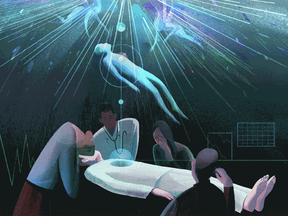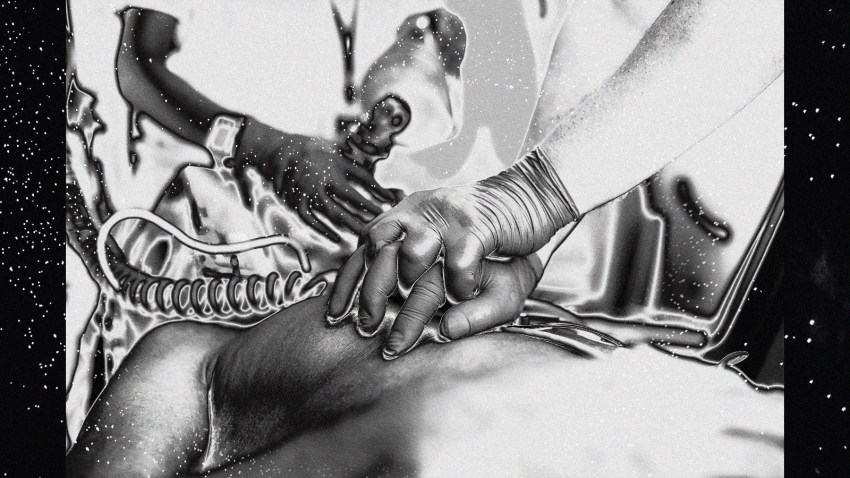Lucidity During Cardiopulmonary Resuscitation
 |
"[In some cases, brain activity returned to near normal physiological levels at different points up to an hour into CPR], suggestive of the emergency of consciousness and resumption of a network-level of cognitive activity.""[A new study of cardiac arrest survivors reporting lucid experiences, including a] purposeful review of their lives [during revival by CPR despite their brains having] flatlined [with no visible signs of consciousness] is leading researchers to new insights where they describe their findings as the] first report of biomarkers of consciousness during CPR -- cardiopulmonary resuscitation]."Research report
 |
| Photo by Cornelia Li for National Post |
"[The aim of the study is to better understand] what's happening in the brain as people transition from life to death, and while we're trying to revive them, and to see if we can find any markers of these lucid experiences of death.""Brakes [are removed while the brain is deprived of blood flow and oxygen, allowing access to deep memories and] hidden dimensions of reality that they would otherwise not be able to access under ordinary circumstances. [An experience that] only comes to the fore in death.""Millions of people have reported having lucid recalled experiences of death and nobody understood what was going on in this phenomenon.""The brain does not have resilience when it comes to oxygen deprivation.""We were able to show that, yes, the brain does lose function, it does flatline. But that for even up to an hour after they have been oxygen deprived, and they're getting resuscitation, that you can see signs of normal brain activity emerge from the flatline state.""[The flatlined brain stays flatlined, for a long period of time, but in between it shows spikes of normal activity] which shows it can mount a normal response. It hasn't permanently died."Dr. Sam Parnia, senior study author, critical care and resuscitation specialist, NYU Langone Health
Published online in the journal Resuscitation, 25 British and American hospitals were involved in the study. The issue was that despite it has always been assumed that people lose consciousness or awareness at least ten minutes after their hearts stop beating, some cardiac arrest survivors, the study revealed, reported lucid experiences.
The study involved 567 patients who, while they were in hospital experienced their hearts stopping. Of that total 43 only survived, were discharged and returned home. Of the discharged patients 28 were sufficiently fit and healthy to take part in an interview. Since so few patients survived, the researchers analyzed testimony from another 126 people separately, who had previously survived cardiac arrest.
Dr. Parnia, lead researcher in the study, believes his team may have discovered a mechanism that explains the seemingly unbelievable claims of near-death experiences: a disinhibited dying brain. "Brakes", he explained, in the brain that restrain information overload are removed while the brain is deprived of blood flow and oxygen. The claims of people having lucid thoughts during these crises have been dismissed by science with the assumption of hallucinations.
The assumption has always been that following ten minutes or so of oxygen deprivation the brain dies. What the study has done is differentiate between losing function immediately within seconds, and the brain's permanent death. A dynamic process where the flatlined brain remains flatlined but spikes of normal activity erupt. Patterns consistent with when we're normally conscious, stresses Dr. Parnia.
When "code" for an in-hospital cardiac arrest was called, participating researchers dispatch to the resuscitation room carrying backpacks holding a portable EEG monitor and portable brain oxygen monitor. Patients were fitted with headphones and a tablet computer was stationed above their heads. The names of three fruits; apple, pear and bananas had been prerecorded on an app installed on the tablet along with ten "visual stimuli", pictures of people, animals, monuments and newspaper clippings.
365 people in total had headphones and computer attached. Of that number some 200 also had brain oxygen monitoring, with 85 having oxygen and EEG monitoring along with a consciousness test. 53, or 9% of the 567 people who went into cardiac arrest survived. Twenty-eight were interviewed, and 11 had memories or perceptions during CPR. And while no one described explicit recall of seeing the tablet images or hearing the recording, when asked to guess randomly, one chose the correct three fruits.
 |
| FreeThink |
"What we realized is that there is a spectrum of consciousness. [At one end, vague perceptions.] At the other end of the spectrum, we have full visual and auditory awareness where people recalled specific details of what was happening to them.""[People reported feeling] as if I was being lifted.""I saw my entire life in great detail. My life and all its events started to play in my mind."Dr. Sam Parnia"That would not have happened 10 years ago, and it would never have happened 20 years ago. We’re living in a different world, and now, this study opens up a new vista and we just have to learn more about it.""My hat is off to Dr. Parnia because he’s trying to seriously study something that we all wonder about. Every one of us who’s taking care of a dying patient — I’ve taken care of thousands — and you wonder, could they be conscious? Might they have a near-death experience?"Dr. Lance Becker, chair, emergency medicine, resuscitation researcher, Northwell Health System, Manhasset, New York
Labels: CPR, Near Death Lucidity, Patient Brain Activity, Study

0 Comments:
Post a Comment
<< Home